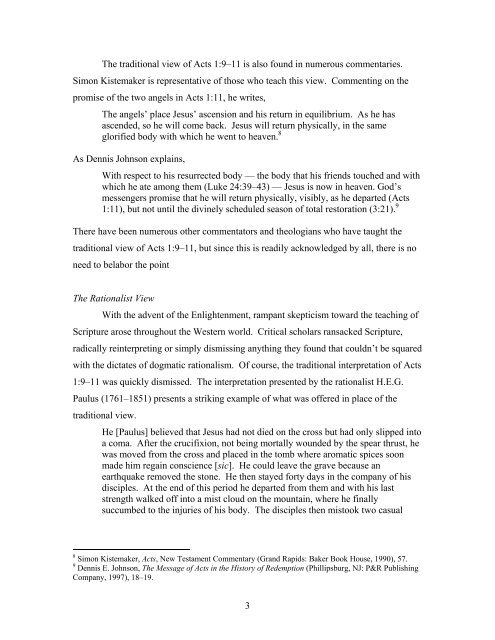Acts 1:9-11 and the Hyper-Preterism Debate by Keith A. Mathison
Acts 1:9-11 and the Hyper-Preterism Debate by Keith A. Mathison
Acts 1:9-11 and the Hyper-Preterism Debate by Keith A. Mathison
Create successful ePaper yourself
Turn your PDF publications into a flip-book with our unique Google optimized e-Paper software.
The traditional view of <strong>Acts</strong> 1:9–<strong>11</strong> is also found in numerous commentaries.<br />
Simon Kistemaker is representative of those who teach this view. Commenting on <strong>the</strong><br />
promise of <strong>the</strong> two angels in <strong>Acts</strong> 1:<strong>11</strong>, he writes,<br />
The angels’ place Jesus’ ascension <strong>and</strong> his return in equilibrium. As he has<br />
ascended, so he will come back. Jesus will return physically, in <strong>the</strong> same<br />
glorified body with which he went to heaven. 8<br />
As Dennis Johnson explains,<br />
With respect to his resurrected body — <strong>the</strong> body that his friends touched <strong>and</strong> with<br />
which he ate among <strong>the</strong>m (Luke 24:39–43) — Jesus is now in heaven. God’s<br />
messengers promise that he will return physically, visibly, as he departed (<strong>Acts</strong><br />
1:<strong>11</strong>), but not until <strong>the</strong> divinely scheduled season of total restoration (3:21). 9<br />
There have been numerous o<strong>the</strong>r commentators <strong>and</strong> <strong>the</strong>ologians who have taught <strong>the</strong><br />
traditional view of <strong>Acts</strong> 1:9–<strong>11</strong>, but since this is readily acknowledged <strong>by</strong> all, <strong>the</strong>re is no<br />
need to belabor <strong>the</strong> point<br />
The Rationalist View<br />
With <strong>the</strong> advent of <strong>the</strong> Enlightenment, rampant skepticism toward <strong>the</strong> teaching of<br />
Scripture arose throughout <strong>the</strong> Western world. Critical scholars ransacked Scripture,<br />
radically reinterpreting or simply dismissing anything <strong>the</strong>y found that couldn’t be squared<br />
with <strong>the</strong> dictates of dogmatic rationalism. Of course, <strong>the</strong> traditional interpretation of <strong>Acts</strong><br />
1:9–<strong>11</strong> was quickly dismissed. The interpretation presented <strong>by</strong> <strong>the</strong> rationalist H.E.G.<br />
Paulus (1761–1851) presents a striking example of what was offered in place of <strong>the</strong><br />
traditional view.<br />
He [Paulus] believed that Jesus had not died on <strong>the</strong> cross but had only slipped into<br />
a coma. After <strong>the</strong> crucifixion, not being mortally wounded <strong>by</strong> <strong>the</strong> spear thrust, he<br />
was moved from <strong>the</strong> cross <strong>and</strong> placed in <strong>the</strong> tomb where aromatic spices soon<br />
made him regain conscience [sic]. He could leave <strong>the</strong> grave because an<br />
earthquake removed <strong>the</strong> stone. He <strong>the</strong>n stayed forty days in <strong>the</strong> company of his<br />
disciples. At <strong>the</strong> end of this period he departed from <strong>the</strong>m <strong>and</strong> with his last<br />
strength walked off into a mist cloud on <strong>the</strong> mountain, where he finally<br />
succumbed to <strong>the</strong> injuries of his body. The disciples <strong>the</strong>n mistook two casual<br />
8 Simon Kistemaker, <strong>Acts</strong>, New Testament Commentary (Gr<strong>and</strong> Rapids: Baker Book House, 1990), 57.<br />
9 Dennis E. Johnson, The Message of <strong>Acts</strong> in <strong>the</strong> History of Redemption (Phillipsburg, NJ: P&R Publishing<br />
Company, 1997), 18–19.<br />
3

















